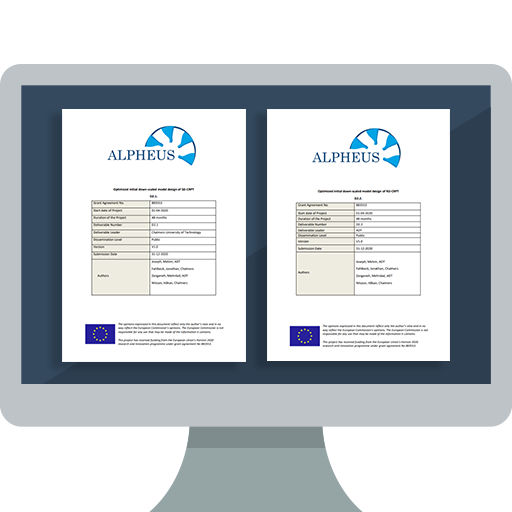Deliverables Achieved: D2.1 and D2.2 of Work Package 2

D2.1
This report describes how the optimised initial down-scaled model design of the Shaft-Driven CounterRotating Pump-Turbine (SD-CRPT) in the ALPHEUS project was derived.
A first design was made in prototype scale, according to the expected requirements of the final machines. The design was scaled to an appropriate model scale with respect to requirements from the experimental test facility at TU Braunschweig. In model scale a numerical sensitivity analysis was conducted on the initial design to narrow down the number of parameters for the optimisation process. With a better understanding of the decisive parameters of the machine, a full optimisation process of the blade geometries were carried out.
The goal with the optimisation procedure was to maximize the average net power considering the power input in pump mode and power output in turbine mode. In addition constraints were imposed on minimum head in pump mode in order to meet the test facility requirements at TU Braunschweig and constraints on risk of cavitation. The latter has a positive effect on fish friendliness, but also may extend the lifetime of the machine. The process has designed an optimised initial downscaled model that is ready to be used for further numerical studies, as well as to start the design and manufacturing of the experimental set-up. It has been decided by the consortium that it is the SDCRPT that will be experimentally studied, rather than the Rim-Driven Counter-Rotating Pump-Turbine (RD-CRPT).
D2.2
This report describes how the optimised initial down-scaled model design of the Rim-Driven CounterRotating Pump-Turbine (RD-CRPT) in the ALPHEUS project was derived.
A first design was made in prototype scale, according to the expected requirements of the final machines. The design was scaled to an appropriate model scale with respect to requirements from the experimental test facility at TU Braunschweig. In model scale a manual optimisation process was conducted in an iterative manner.
The goal with the optimisation procedure was to increase the efficiency for a wide range of operating conditions in both pump and turbine modes. The process has resulted in a design of a down-scaled model with far better performance than the initial design. The RD-CRPT design is ready to be subjected to further numerical sensitivity analysis and multi-objective optimisation. It has been decided that it is the Shaft-Driven Counter-Rotating Pump-Turbine (SD-CRPT) that will be experimentally studied, rather than the RD-CPRT due to the fact that the Rim driven configuration cannot use “off the shelf” motor/generators components.

